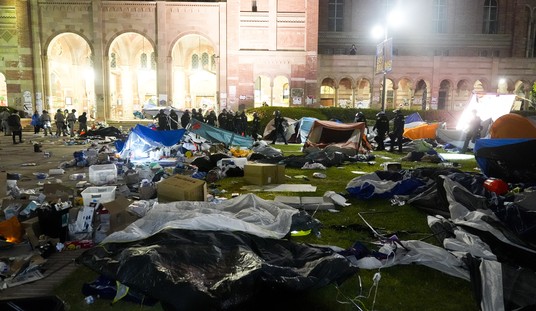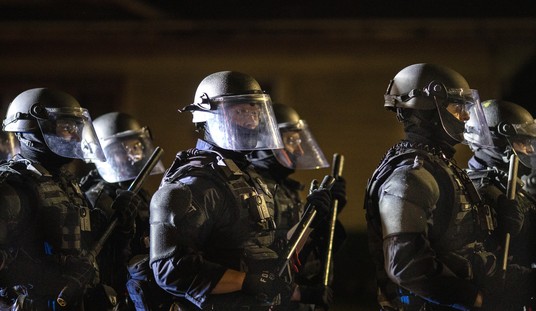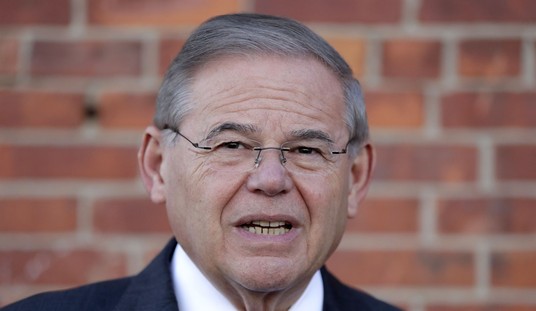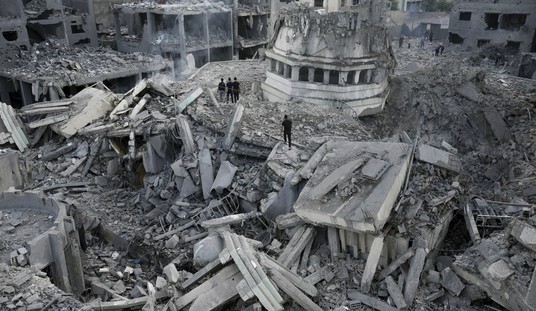The Armed Forces of the United States and the United Kingdom carried out a massive air and missile strike against sites in Yemen associated with attacks on commercial maritime traffic in the international waters of the Red Sea. My colleague Nick Arama covered Biden's announcement last night. I'm going to try to fill in some details of why this attack happened now, what, if anything, it accomplished, and what happens next.
BACKGROUND: BREAKING: US, UK Start Attacks on Houthis; Biden Issues Statement, Then Calls Lid
Why Now?
After a couple of dozen attacks on shipping in international waters and a handful of stern warnings, it is fair to ask why the attack came when it did.
While pressure had been building for a while to do something about the effect Houthi missile and drone attacks were having on international commerce, the proximate cause came Thursday, when four US-flagged ships came under a complex drone/missile attack while the USS Dwight D. Eisenhower carrier strike group escorted them.
10/On Jan 9 - four US ships came under direct attack - Alliance Norfolk, Green Bay, Liberty Glory and Maersk Atlanta - with several nearly hit. Their passage provoked the largest and most complex attack executed by the Houthi with 18 UAVs, two cruise and one ballistic missile. pic.twitter.com/sJa7WpecRj
— Sal Mercogliano (WGOW Shipping) 🚢⚓🐪🚒🏴☠️ (@mercoglianos) January 12, 2024
BACKGROUND: Houthis Launch Largest Attack So Far Targeting American-Flagged Merchant Ships With American Sailors
All past attacks had been against foreign-flagged ships. The defense of US-flagged ships is the responsibility of the Departments of Defense and Transportation. For the first time since the attacks began, Secretary Buttigieg was able to tear himself away from whatever it is that he does (please, no pictures and no descriptions) and express alarm over the closure of a sea lane serving over 10 percent of global maritime traffic.
These attacks in the Red Sea are unlawful and reckless. The safety of U.S. mariners is our priority, and DOT's Maritime Administration is in coordination with DOD and U.S.-flagged vessels to ensure their security. https://t.co/3eCNrU8NvS
— Secretary Pete Buttigieg (@SecretaryPete) January 11, 2024
The short answer is that by attacking US-flagged ships escorted by a US Navy CSG, retaliation was guaranteed.
The Lead Up
One of the hallmarks of the Biden NSC under Jake Sullivan is its shameful timidity. It has demonstrated this by dragging out the war in Ukraine because Sullivan has been terrified of each of the eleventy-seven "red lines' Vladimir Putin or one of his catchfarts have declared but failed to act on. This was no different. Hours before the strikes, word was leaked that the US and UK were attacking last night. This gave critical personnel time to skedaddle, and plenty of time to move vital equipment.
These attacks in the Red Sea are unlawful and reckless. The safety of U.S. mariners is our priority, and DOT's Maritime Administration is in coordination with DOD and U.S.-flagged vessels to ensure their security. https://t.co/3eCNrU8NvS
— Secretary Pete Buttigieg (@SecretaryPete) January 11, 2024
The attacks, according to the Houthis, killed five and wounded six of its terrorists. This is consistent with everyone heading for the high timber. Of course, it means the planners and technicians required for these attacks will be available to pick up where they left off.
The Attack
There isn't a lot of definitive information on the strikes. What follows is my interpretation of parsing through several accounts.
The US and UK launched some 72 strikes against 60 targets in 16 locations.
The Pentagon described its targets as radar systems, drone storage and launch sites, missile storage and launch facilities and Houthi command and control nodes
The French were asked to join and declined. With the French, you are never quite sure what their game is; in this case, I believe they think the Biden-Austin-Blinken-Sullivan foreign policy team is weak and erratic, and they don't want to be roped into some fiasco like Kabul in 2021.

The attack seems to have been conducted in two waves. About 60 strikes initially and about 12 follow-up strikes. This infographic probably has some holes in it, but it gives a good representation of the scope of the retaliatory strike.

Combat videos follow.
An E-2C Hawkeye airborne early warning aircraft launching from the USS Dwight D. Eisenhower in advance of the F/A-18s of the strike package.
THE AIRSTRIKES AGAINST YEMEN ARE NOT OVER. THEY WILL MOST LIKELY CONTINUE OVER THE WEEKENDpic.twitter.com/7yfSEJKqub
— WORLD AT WAR (@World_At_War_6) January 12, 2024
RAF Typhoons launching from Cyprus.
Declared UK contribution was 4 Typhoon jets flying from RAF Akrotiri in Cyprus - a very long trip of several thousand miles - which required air-air refuelling support.
— Navy Lookout (@NavyLookout) January 12, 2024
Using Paveway IV Laser Guided bombs to hit 2 targets – a site said to be used for launching drones and an… pic.twitter.com/SN5NH93AHL
Ordnance impacts.
instead of force Israel to stop the genocide against Palestinians people in Gaza strip and west bank. USA and UK are bombing Yemen right now. WTF!
— (صفية) بنت صنعاء القديمة (@Safia_Alsnaani) January 12, 2024
This world is so crazy and so fucking missed up.#remaniement#RedSea#Yemen
pic.twitter.com/Hjky5ix7fq
MoD says Typhoons bombed sites at Bani in north-western Yemen and the airfield at Abbs. Intelligence has shown these facilities were used to launch both cruise missiles and drones over the Red Sea. pic.twitter.com/pSlvOoRyP4
— Navy Lookout (@NavyLookout) January 12, 2024
Attack Locations
This map is courtesy of the UK Ministry of Defense.

The Attack Results
I haven't seen anything that resembles battle damage assessment. Given that the strikes were at stationary targets defended by a Stone Age society, it is safe to assume whatever was aimed at was hit. The question is, what potential targets were placed off limits? Due to the obvious attempt to not rack up a Houthi body count, I have to assume the ghost of LBJ picking targets in North Vietnam to bomb while in the White House basement was very present.
The Political Results
The Houthis were not happy. This is the "Death to Israel. Death to America" crowd.
#BREAKING 📢📢📢 "Death to America! Death to Israel!" In most cities of Yemen, where demonstrations were also held in support of the Ansarullah movement, this slogan became the main one for the demonstrators #Gaza #us #Yemen #Houthis pic.twitter.com/bZmlmmYxSF
— Slavic Bear News (@slovenskimedved) January 12, 2024
And the obligatory angry crowd.
🇾🇪MILLIONS of YEMENIS march today chanting “We don’t care, we don’t care, we don’t care, make it a major global war!” after the US🇺🇸 & UK🇬🇧 BOMBED their homeland last night.#Yemen#YemenUnderAttack
— ENG. H.K.Z 🇺🇲 (@The___Leader_) January 12, 2024
pic.twitter.com/Jj7chCTYCZ
As always, you can count on some of the high-follower accounts who claim to be conservative Christians but support Russia's war in Ukraine to take the side of the terrorists.
🚨🇾🇪 AMERICAN PATRIOTS STAND WITH YEMEN! pic.twitter.com/319tiH8SLJ
— Jackson Hinkle 🇺🇸 (@jacksonhinklle) January 12, 2024
There were two noticeable events today. The Houthis fired on a Russian oil tanker outside the Bab el-Mandeb Strait. This shows a breakdown in command-and-control and target acquisition abilities on the part of the Houthis.


They also fired at another ship. This one is also outside the Bab el-Mandeb Strait. Notice how this attack differs from the other attacks?

We'll see if the pattern holds up of the Houthis continuing to fire missiles, but they won't do it inside the Red Sea. If so, this is a success.
Analysis
We'll know in the next week if this strike has achieved its purpose. But it would be a safe guess that after a period of licking their wounds, or whatever it is that Houthis prefer to lick, and evaluating the situation, they will be back in action.
If you've watched Jake Sullivan in action for the last three years, you know, instinctively, that he's signaling like hell to Tehran that he doesn't want this freedom of navigation exercise to continue. By linking the attack on four US-flagged ships to the strike Thursday, I think the Houthis will take this as a signal that it is still open season on international traffic.
On the whole, I think we'll come away from this looking weaker to our enemies rather than stronger. The message we will send to our allies is that we are too timid to act.
Update [10:51 p.m. EST, 1/12/24]: The New York Times is reporting in a news brief late Friday that the United States has lauched a second round of air attacks on Houthi targets in Yemen:
The United States carried out another round of strikes against Houthi militants, two U.S. officials said on Friday, bombing a radar facility in Yemen as part of an effort that Pentagon planners hoped would further degrade the Iran-backed group’s ability to attack ships transiting the Red Sea.
This is a developing story. When RedState gets further updates, we'll bring you the details.














Join the conversation as a VIP Member